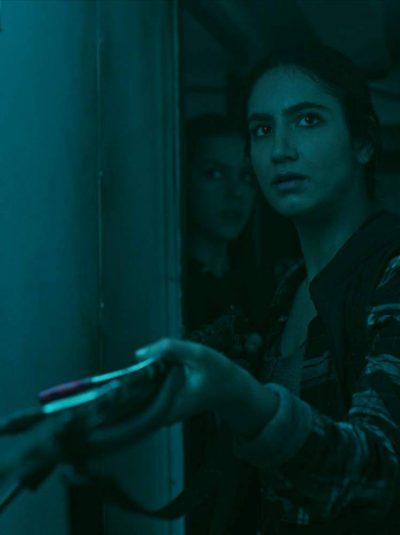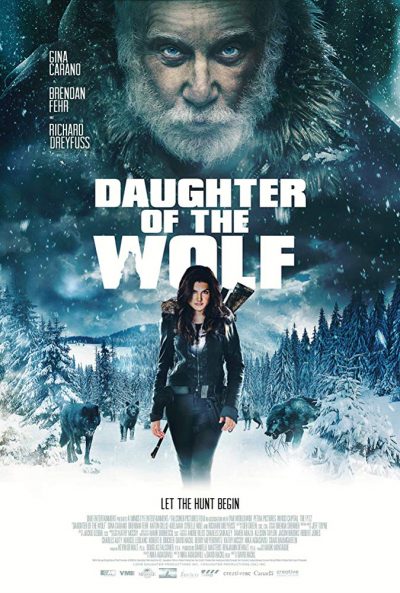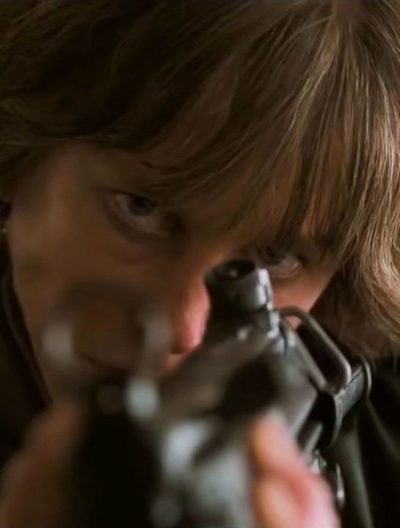★★★½
“Mother of all predators”
 This strange little film probably makes more sense if you’ve seen The Woman, in which a feral cannibalistic woman, played by McIntosh, was captured and kept in the basement of a dysfunctional family. While this features McIntosh in the same role, it does work as a standalone film: its predecessor may help explain some of the background. Here, the woman drops off her equally uncivilized teenage daughter (Canny) at a hospital. Unsure of quite how such an unusual child should be handled, Darlin’ – called that, because of a bracelet spelling that out which she is wearing – is handed over to the Catholic church.
This strange little film probably makes more sense if you’ve seen The Woman, in which a feral cannibalistic woman, played by McIntosh, was captured and kept in the basement of a dysfunctional family. While this features McIntosh in the same role, it does work as a standalone film: its predecessor may help explain some of the background. Here, the woman drops off her equally uncivilized teenage daughter (Canny) at a hospital. Unsure of quite how such an unusual child should be handled, Darlin’ – called that, because of a bracelet spelling that out which she is wearing – is handed over to the Catholic church.
In particular, to St. Philomena’s Home, a dubious institution run by an even more dubious Bishop (Batt). He sees in Darlin’ the chance for his parish to make a name for itself by “redeeming” their new ward in the name of the Lord, which would help them stave off an impending financial crunch. But when the Woman returns to the hospital, and finds her daughter is no longer there, it quickly becomes clear that she will go to any lengths to recover Darlin’ and punish those who are trying to exploit her. And even though the teenager is no longer quite the wild child she was, as the saying goes: You can take the child out of the woods, but you won’t necessarily take the woods out of the child…
McIntosh is probably best known for her work on The Walking Dead. But on this site, we adore her for Let Us Prey, and her directorial debut is little if any less savage. However, it is probably fair to say that the script – also written by McIntosh – tries to cram too many things into its pages, and comes up short as a result. Not to say there aren’t moments of supreme effectiveness. Just that they are diluted by the film’s desire to go in so many different directions. For example, despite the Woman’s apparently inexorable quest for Darlin’, she vanishes for much of the second half, instead just hanging round a homeless women’s encampment to no particular purpose. It’s a shame, as I don’t think I’ve seen a more genuinely scary female character in a film for a very long time. [Though Darlin’ doesn’t fall far from that tree, at least initially]
The rest is more hit or miss. Going after the Catholic Church for child abuse is… Well, it feels kinda obvious, though there’s a righteous anger here which does at least seem honest. And the civilized version of Darlin’, despite now being able to communicate through speech rather than growls, seems less interesting, as if she had lost much of what separated her from any other teenage girl. Neither of these really work so well, as the more linear concept of a mother prepared to do absolutely anything to reclaim her daughter, which is when the film is at its best and most memorable.
Dir: Pollyanna McIntosh
Star: Lauryn Canny, Bryan Batt, Nora-Jane Noone, Pollyanna McIntosh





 In the late 22nd-century, Earth is pretty much screwed. The impact of a giant meteor killed a huge number of people, wiped out the everyday infrastructure, and sent the world into perpetual twilight. Thirty years ago, the wealthy upped and left, never to be seen again, abandoning the rest of the survivors to scramble in the ruins of civilization, simply trying to survive. Holly Danger is one of them, a salvager who lives by her wits in the labyrinth of a coastal city’s destruction. Which means dodging the seekers, addicts of the hyper-destructive drug, Plush, as well as the outskirts, those who come in to the city and raid it for supplies.
In the late 22nd-century, Earth is pretty much screwed. The impact of a giant meteor killed a huge number of people, wiped out the everyday infrastructure, and sent the world into perpetual twilight. Thirty years ago, the wealthy upped and left, never to be seen again, abandoning the rest of the survivors to scramble in the ruins of civilization, simply trying to survive. Holly Danger is one of them, a salvager who lives by her wits in the labyrinth of a coastal city’s destruction. Which means dodging the seekers, addicts of the hyper-destructive drug, Plush, as well as the outskirts, those who come in to the city and raid it for supplies. Christine McCullers (Gubelmann) is a new cop, out on patrol with her father, a long-time veteran of the force. A poor decision involving a robbery suspect leaves Dad dead and Christine crippled. Re-assigned to dispatch, things go from bad to worse, when she gets a call from a kid, which she takes to be some kind of prank. It’s very real, and the caller’s friend ends up murdered as a result. Crucified by social media – not least due to her popping of painkillers to deal with her injury – she’s suspended from duty. Believing the killers are not the victim’s parents as her colleagues think, Christine begins her own investigation to try and achieve redemption through finding the real murderer.
Christine McCullers (Gubelmann) is a new cop, out on patrol with her father, a long-time veteran of the force. A poor decision involving a robbery suspect leaves Dad dead and Christine crippled. Re-assigned to dispatch, things go from bad to worse, when she gets a call from a kid, which she takes to be some kind of prank. It’s very real, and the caller’s friend ends up murdered as a result. Crucified by social media – not least due to her popping of painkillers to deal with her injury – she’s suspended from duty. Believing the killers are not the victim’s parents as her colleagues think, Christine begins her own investigation to try and achieve redemption through finding the real murderer. While initially released as a film, what’s reviewed here is the extended cut, screened as four 45-minute episodes on Russia’s Channel One in May 2016. This is easily available, on both Amazon Prime and
While initially released as a film, what’s reviewed here is the extended cut, screened as four 45-minute episodes on Russia’s Channel One in May 2016. This is easily available, on both Amazon Prime and  My heart sank in the first few seconds, when I discovered that this was a SyFy Original Movie. The really poor CGI, of a ship sailing on the ocean, seemed to confirm that I was in for one of their bottom of the barrel productions. In the end, however, this was… just about okay. Incredibly derivative, to be sure, and that’s not its only problem. Yet it still just about sustained my interest. That’s certainly not always the case for SyFy Original Movies, to put it mildly.
My heart sank in the first few seconds, when I discovered that this was a SyFy Original Movie. The really poor CGI, of a ship sailing on the ocean, seemed to confirm that I was in for one of their bottom of the barrel productions. In the end, however, this was… just about okay. Incredibly derivative, to be sure, and that’s not its only problem. Yet it still just about sustained my interest. That’s certainly not always the case for SyFy Original Movies, to put it mildly. The cinematic goodwill Carano accumulated as the result of her electric debut in
The cinematic goodwill Carano accumulated as the result of her electric debut in  Some years ago, my Goodreads friend Mary J.L. gave the original novel of the author’s Nadia Stafford trilogy a favorable review, and that put it on my radar. As a rule, I don’t read novels that are only published in electronic format (it does have a audio version, but I don’t listen to audio books either), but I do read short e-stories; electronic publishing provides a forum for those works which no longer exists in print, what with the demise of general-circulation magazines. This tale, as a novella, occupies a middle ground, but commercially novellas are in much the same boat as short stories –a single one wouldn’t sell very well in print format. So I felt it was fair to treat it the same way, and thought it would be a good way to check out the series for myself.
Some years ago, my Goodreads friend Mary J.L. gave the original novel of the author’s Nadia Stafford trilogy a favorable review, and that put it on my radar. As a rule, I don’t read novels that are only published in electronic format (it does have a audio version, but I don’t listen to audio books either), but I do read short e-stories; electronic publishing provides a forum for those works which no longer exists in print, what with the demise of general-circulation magazines. This tale, as a novella, occupies a middle ground, but commercially novellas are in much the same boat as short stories –a single one wouldn’t sell very well in print format. So I felt it was fair to treat it the same way, and thought it would be a good way to check out the series for myself. This one might sound familiar, as I did previously review it
This one might sound familiar, as I did previously review it  There were aspects which still befuddle me, such as most of the plot. Why, exactly, is Angela Mao pretending to be a boy? It’s completely unconvincing, and entirely unnecessary to the story-line. No-one ever discovers her true gender: it’s almost as if this were originally written for a man, then they got Mao, and in all the excitement, forgot (or, alternatively and equally credibly, couldn’t be bothered) to change the script. The rest of it is an odd mix. It’s partly vengeance with Fei Fei (Mao) out to pick up enough martial arts skill to take revenge on those who killed her family. Yet this sits alongside slapstick comedy which you’d not expect given the title, such as the two kung fu masters – one drunk, one stoner – whom she tricks into sharing her talents, or the villain with the world’s tiniest fan whom she defeats on her way to the big bad.
There were aspects which still befuddle me, such as most of the plot. Why, exactly, is Angela Mao pretending to be a boy? It’s completely unconvincing, and entirely unnecessary to the story-line. No-one ever discovers her true gender: it’s almost as if this were originally written for a man, then they got Mao, and in all the excitement, forgot (or, alternatively and equally credibly, couldn’t be bothered) to change the script. The rest of it is an odd mix. It’s partly vengeance with Fei Fei (Mao) out to pick up enough martial arts skill to take revenge on those who killed her family. Yet this sits alongside slapstick comedy which you’d not expect given the title, such as the two kung fu masters – one drunk, one stoner – whom she tricks into sharing her talents, or the villain with the world’s tiniest fan whom she defeats on her way to the big bad. A fine, almost unrecognizable performance by Kidman succeeds in maintaining interest, despite a script which appears to regard time less like an arrow, and more like a big ball of wibbly-wobbly, timey-wimey stuff. Deeply troubled cop Erin Bell (Kidman) wakes up in her car, apparently badly hungover, looking like ten pounds of crap in a five-pound bag. Not far away, her colleagues are poring over a newly-discovered murder scene: a body with a dye-stained hundred-dollar bill on the corpse. And that’s about the last time when I was quite certain of the timeline.
A fine, almost unrecognizable performance by Kidman succeeds in maintaining interest, despite a script which appears to regard time less like an arrow, and more like a big ball of wibbly-wobbly, timey-wimey stuff. Deeply troubled cop Erin Bell (Kidman) wakes up in her car, apparently badly hungover, looking like ten pounds of crap in a five-pound bag. Not far away, her colleagues are poring over a newly-discovered murder scene: a body with a dye-stained hundred-dollar bill on the corpse. And that’s about the last time when I was quite certain of the timeline. Marginally competent, and just not very exciting, this low-budget offering is the story of December (Kurishingal). As a young girl, she watched as the rest of her family was slaughtered by Law (Ramsey) and his villains, the result of a debt owed by her father. A decade or so late, she has grown up and taken to the streets as a vigilante, seeking vengeance on those responsible. Or, until she finds them, any other perpetrators she comes across during her night-time ramblings through the mean back alleys of the city. Helping her mission, is that she now works for the police, which puts her in a prime position to ensure, for example, that any evidence pointing in her direction goes “missing”.
Marginally competent, and just not very exciting, this low-budget offering is the story of December (Kurishingal). As a young girl, she watched as the rest of her family was slaughtered by Law (Ramsey) and his villains, the result of a debt owed by her father. A decade or so late, she has grown up and taken to the streets as a vigilante, seeking vengeance on those responsible. Or, until she finds them, any other perpetrators she comes across during her night-time ramblings through the mean back alleys of the city. Helping her mission, is that she now works for the police, which puts her in a prime position to ensure, for example, that any evidence pointing in her direction goes “missing”.